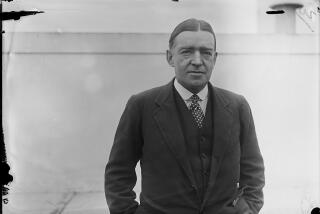Dutchman May Have Found Antarctica in 1599
- Share via
AMSTERDAM — It’s an ice place, but you wouldn’t want to live there.
A Dutch sea captain’s ominous descriptions of a gigantic icy land mass four centuries ago have some scholars convinced that he’s the man who really discovered Antarctica, 221 years before the Russian and the Englishman credited with the discovery.
Notes penned in 1622 by the Amsterdam merchant who bankrolled the voyage mention how Dirck Gerritsz described seeing the land mass in 1599, a year after he sailed from Rotterdam, Dr. Wim Ligtendag of Groningen University’s Arctic Center said Friday.
The merchant, Isaac Le Maire, wrote how Gerritsz’s weather-beaten ship, the Flying Heart, had been driven far south of Cape Horn by a strong north wind that had blown for weeks.
“At 64 degrees south of the Strait of Magellan, he saw a mountainous land, like Norway, entirely white with snow and so extensive that it seemed as if it stretched as far as the Solomon Islands,” Le Maire wrote.
If true, it means that Antarctica wasn’t discovered by Edward Bransfield, an Englishman, and Thaddeus von Bellingshausen, a Russian admiral, who share the credit for making the continental discovery two centuries later in 1820.
In the past, Le Maire’s account was brushed aside as hearsay by historians who didn’t find it convincing enough. Ligtendag said his research has established that Le Maire and Gerritsz were probably in close personal contact, adding weight to the writings.
Though Britons joke about discovering Antarctica as a source for ice for their gin-and-tonics, experts don’t think much of the notion that a Dutchman may have beaten them to the punch.
“One can’t completely dismiss it, but one puts it on the ‘extremely unlikely’ list,” said Robert Headland, archivist and curator of the University of Cambridge’s Scott Polar Research Institute.
“There’s nothing to corroborate it,” he said Friday. “I’m inclined to dismiss it as another one of those South Pole rumors.”
The Dutch study, commissioned by the Netherlands Organization for Scientific Research, will be published in “The Discovery of the Far South: The History of Antarctica as Revealed by Old Maps and Charts,” a new book by Ligtendag.
More to Read
Sign up for Essential California
The most important California stories and recommendations in your inbox every morning.
You may occasionally receive promotional content from the Los Angeles Times.












